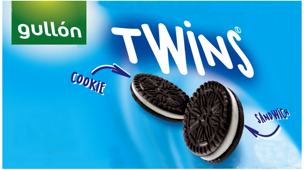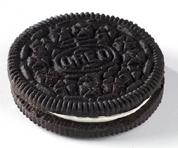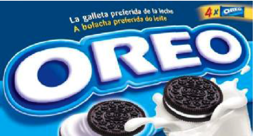
Since 2015, two major biscuit manufacturers, have been doing battle, first at the EUIPO and then on appeal up to the Board of Appeal and the General Court (GC) of the Court of Justice of the EU, over rights to register, and the extent of trade mark monopolies in, “sandwich biscuits”. They have also been in dispute in Spain. The GC issued its decision on 28 May 2020.
This article examines the decisions, which are in Spanish, and their implications for trade mark owners. Images of the marks are taken from the EUIPO, WIPO or Spanish IPO databases, or the decisions.
Background
Spanish biscuit company Galletas Gullón, S.A. applied in March 2015 to register the figurative mark 013877543 (Figure 1) in class 30 for cookies. Oppositions were filed by Kraft Foods España Intellectual Property, S.L. and Intercontinental Great Brands LLC. Kraft’s opposition was withdrawn, but the one by Intercontinental went through appeals to the GC.

Figure 1
Intercontinental’s opposition was based on:
a) 3D EUTM 008566176 (Figure 2) (note the word OREO is on the top of the biscuit) registered on 22 February 2010 based on preparations made from cereals; pastries and confectionery under likelihood of confusion (article 8.1.b) and reputation (article 8(5) ) in biscuits in Spain and the EU, and
b) Spanish registration 2845539 (Figure 3) described on the Spanish register as a mixed mark based on various types of biscuit, again on the basis of likelihood of confusion and reputation.

Figure 2

Figure 3
Result and Comments
The opponent was successful, based on the reputed EUTM 008566176, at first, second and third instance. This may seem somewhat surprising, if you take the view, as the applicant did, that such a decision would effectively give the opponent a monopoly in biscuits which have a sandwich form, with two black (or dark brown) round biscuits and a white filling, and that the word elements of each mark are very different.
However, this is a case that turned very definitely on the evidence filed. It is clear that Intercontinental dedicated very significant resources to gathering and presenting their evidence, which related mainly to Spain. The Opposition Division said this showed, amongst other things:
- that OREO biscuits had been sold in Spain since the 1990s and have been sold there, and elsewhere, ever since;
- sales in Spain were over 114 million Euros 2012 - 2015;
- advertising figures of over €5 million;
- a market survey showing OREO biscuits are the fifth most spontaneously recognised biscuit in Spain and recognised by 96%;
- images of OREO biscuits on sale in different venues in Spain;
- other promotional activities including an OREO bus route along the Spanish coast in the summer of 2015 and a lot of other publicity material;
- Spanish press reports including an OREO centenary in 2012;
- certificates of recognition by Madrid and Barcelona Chambers of Commerce of the mark OREO, packaging and three dimensional shape;
- additional market studies;
- recognition of the fame of the opponent’s marks in the Community court of Alicante and confirmed by the Spanish Supreme Tribunal in 2015.
The Opposition Division concluded that the evidence clearly demonstrates that the earlier mark (Figure 2) has been used in a prolonged and intensive manner and benefits from a reputation in Spain, with a consolidated position as a market leader, as shown by independent sources. The very wide-reaching publicity activities were given particular emphasis, as they would have reached a large part of the population. They also concluded that a large percentage of the public, associated sandwich biscuits with a single commercial origin, even if not identified with the sign OREO.
At every level, the fact that each mark at issue had different word elements, and that the applicant’s mark had multiple different words, colours and graphical elements, did not prevent the marks from being held to be sufficiently similar for the purposes of upholding the opposition based on the reputed OREO three dimensional mark. Note that the case was not examined based on likelihood of confusion, even though this was one of the original grounds. Nor did it help the applicant that there are other sandwich biscuit marks, and that the representation of the opponent’s sandwich biscuit is not highly distinctive.
What seems to have been key, is the various market surveys the opponent conducted in Spain. The General Court highlighted the fact that 76% of people surveyed, spontaneously associated a picture of an OREO biscuit, (without the word OREO), with the OREO brand.
The Board of Appeal also mentioned that the result of one of the surveys submitted as evidence, is that of those surveyed who would associate the image they were shown of the opposed mark with a brand, 73% spontaneously associated the opposed mark with OREO, 72% due to the form of the biscuit. The GC concluded “This means that the public associate the two marks despite the word elements in the opposed mark, and regardless of whether the element “Gullón” itself is widely known.”
The decisions referred to an exceptional level of reputation of the earlier mark. This was to the opponent’s advantage, in making up for a low level of similarity between the marks, in establishing consumers would make a link between the marks of the parties, and that the applicant was taking advantage of the opponent’s fame and investment in publicity, in order to sell their own products. This was despite the presence of the applicant’s name Gullón in the mark.
It’s worth noting that the Board of Appeal mentioned that the Supreme Tribunal in Spain upheld the fame of the earlier marks (Figure 2) and (Figure 3) but rejected a claim of unfair competition of a different Gullón mark, which nevertheless featured sandwich biscuits, (Figure 4).

Figure 4
The Board of Appeal went on to distinguish that decision, because of differences in representations of the biscuits, the different evidence presented, and the fact that the Spanish court mainly conducted a comparison of the word elements OREO v MORENAZOS.
They also distinguished the Spanish IPO’s decision to grant the identical mark to the one being challenged now in class 30, partly because the opposition in that case was based on likelihood of confusion, not on reputation.
The Board of Appeal noted that while in composite marks, usually words have more distinctive character than figurative elements, there are exceptions to this. They observed that food is usually chosen directly by the consumer, and not requested by name, and that consumers don’t spend time reading all the packaging, so visual impression is what guides their selection.
The GC upheld the reasoning of the Board of Appeal, and agreed with them that the applicant’s case was not helped by the fact the EUIPO had refused protection of the EU designation of IR 1282903 (Figure 5) (a representation of the opponent’s biscuit, but without the word OREO), because, as the GC pointed out, the way to challenge the distinctive character of a mark is by filing an invalidity action; an earlier mark cannot be declared invalid in opposition proceedings.

Figure 5
When comparing the marks, the GC concluded that no single element was either dominant or insignificant in the comparison of the marks, but they felt that consumers’ attention was drawn to the representation of the biscuits in the applicant’s mark, for example by the use of arrows, that it was improbable that consumers would examine the individual elements of the earlier mark, and even if they did, their attention would not only be drawn to the word OREO.
The GC referred to previous case law confirming that a 3D mark can acquire distinctive character and reputation, even if used with a word element, and stated that evidence of 2D representations of a 3D mark can form part of the totality of the evidence for a 3D mark.
They rejected the applicant’s criticisms of the surveys.
Take home points
Strong evidence can make all the difference.
The level of evidence submitted by the opponent in this case takes many, many hours and thousands of Euros to collate and submit.
The opposition might well have failed, despite all their evidence, had the applicant represented their sandwich biscuits in a less similar way to that of OREO biscuits, in terms of colours and shape. Incorporating numerous other elements seems to have counted against the applicant in this mark; that will not always be the case.
Survey evidence tends to be treated with very significant judicial scepticism in the UK, but can be key in EUIPO proceedings.
View the EUIPO Opposition Division’s decision in opposition 2565342, in Spanish, here.
View the Board of Appeal’s decision in the appeal R2378/2017-2, in Spanish, here.
View the GC’s decision T-677/18, in Spanish, here.
Sofia is an IP Director and Chartered Trade Mark Attorney at Mewburn Ellis. She handles all aspects of trade mark work, with a particular focus on trade mark searches, contentious proceedings such as complex families of oppositions and similar actions in multiple jurisdictions, and managing extensive international trade mark portfolios. Sofia is experienced in drafting and negotiating settlement agreements, often in tandem with contentious proceedings. She has extensive experience of oppositions, revocation and invalidity actions in the UK as well as EUTM oppositions. Sofia has represented clients at hearings before the UK-IPO and in appeals before the Appointed Person, while also being involved in appeals to the English courts and the European General Court.
Email: sofia.arenal@mewburn.com
Sign up to our newsletter: Forward - news, insights and features
Our people
Our IP specialists work at all stage of the IP life cycle and provide strategic advice about patent, trade mark and registered designs, as well as any IP-related disputes and legal and commercial requirements.
Our peopleContact Us
We have an easily-accessible office in central London, as well as a number of regional offices throughout the UK and an office in Munich, Germany. We’d love to hear from you, so please get in touch.
Get in touch

